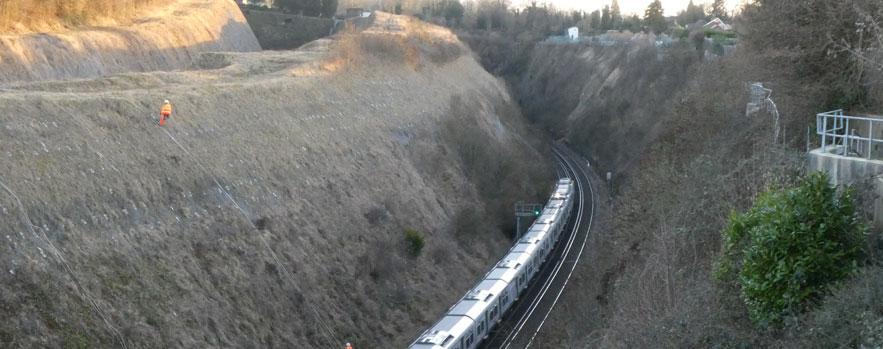
Background
The Hooley Cutting, near south London, carries the main railway line from London to Brighton through the North Downs. The 30m-deep cutting slopes are susceptible to landslides and need measures to prevent rockfalls reaching the tracks, which have caused train derailments and line closures in the past.
The cutting slopes have been covered with rockfall mesh to collect any falling debris, but there have been failures behind the mesh causing the mesh to bulge towards the track. Such failures are hard to predict and a team of ground engineers is required to carry out regular inspections to monitor at-risk locations and ensure mesh integrity. A method was needed to provide an early warning of slope failures on the network.
Network Rail commissioned CSIC to devise a solution to the problem. South East Region Managing Contractor Bam Nuttall and ground engineering company Bam Ritchies joined the project team; both organisations have extensive experience of trackside installation and management. CSIC proposed using strain change that slope failure produces in the mesh, to help identify and predict problematic areas before they impact on the safety of the railway
Innovative sensor systems
CSIC designed and trialled two different fibre optic sensing systems for the cutting. The first used discreet Fibre Bragg Grating (FBG) sensors and the second, Distributed Fibre Optic Strain Sensing (DFOS). The FBG system prepared by CSIC included a multi-channel interrogator developed by Beijing Information and Science Technology University (BISTU) and FBG strain sensors spaced 20m apart packaged in a steel armoured cable. The distributed system, manufactured by CSIC collaborator Febus (see case study 5), is a commercially available long-range dynamic Brillouin system capable of 50 measurements per second over 1000 sensing points along a 1km length. For this trial, the system was used in fast-static mode measuring all points along the length of the entire fibre sensor in 30 seconds.
BAM Ritchies engineers abseiled from the top of the cutting to fix dual cable clamps (specially designed and manufactured for this project by CSIC) to the cutting face using soil nails at fixed intervals of 20m gauge length. The sensor cables were pre-tensioned and clamped in place, and attached to the rockfall mesh along its length. The installation spanned a 100 metre width for the test location, and included four dual-rows of sensor cable from the base to the apex of the cutting.
Monitoring the cutting and data processing
The sensor cables were routed to a control room where the two optical analysers were located. Once the system was established, the system could report the location of any change in strain of the mesh, which could indicate accumulation of debris. Dynamic measurements from the FBG sensing system were sampled at a 10Hz frequency and the raw data files from these measurements were transferred over the network for processing. This work is led by CSIC Research Associate Dr Xiaomin Xu. In order to test the sensitivity of the system, a trial was carried out in February. The trial was carried out using a tirfor winch to lift the mesh in a controlled way. The tirfor was anchored at the top of the slope, on the crest, while its hook was attached to the mesh at a location close to the fibre optic cables. The figure below shows a snapshot of the strain change histories, measured with the various FBG sensors during the trial of the system. Each chart plots the strain measured at two or three locations on the slope. As seen, stretching of the mesh near sensor A5 results in highly localised strain, while other gauges remain mostly unaffected.
Delivery of a new practice
This project has demonstrated potential benefits for the future of rockfall monitoring. The sensor systems could replace regular inspections, so engineers would only be required to investigate locations the system has alerted them to, saving time and reducing risks. The systems could also contribute to rail safety if the sensor system was to be incorporated into an early warning system allowing better intervention and action such as alerting train drivers to the possibility of debris on the tracks. Processing real-time digital data off-site, alongside machine learning and artificial intelligence, could also help to recognise data patterns and identify trends that are known to lead to worsening conditions. By sensing railway infrastructure, such as earthworks and embankments, assets become smart, enabling information about their state to be shared with asset owners. It becomes part of an ‘internet of infrastructure’, (which has the potential to transform practice, as with the Internet of Things (IoT)) by making inanimate objects interact with a knowledge system.
"Network Rail is keen to investigate and assess emerging technologies for detection of rapidly moving earthworks failures in line with the Network Rail Earthworks Technical Strategy. The project at Hooley has demonstrated the potential for use of optical fibres for failure detection, increasing the options available to us for monitoring our earthworks and allowing timely detection of failures. We are keen to look at how we can best develop the application of the technology for use more widely across the network, with particular interest in the potential application for failure detection over long lengths of earthworks." Neil Esslemont, Senior Engineer, Network Rail
Contact: Phil Keenan, 01223 748586 / ptk23@cam.ac.uk
Team: Dr Cedric Kechavarzi, Dr Xiaomin Xu and Phil Keenan
